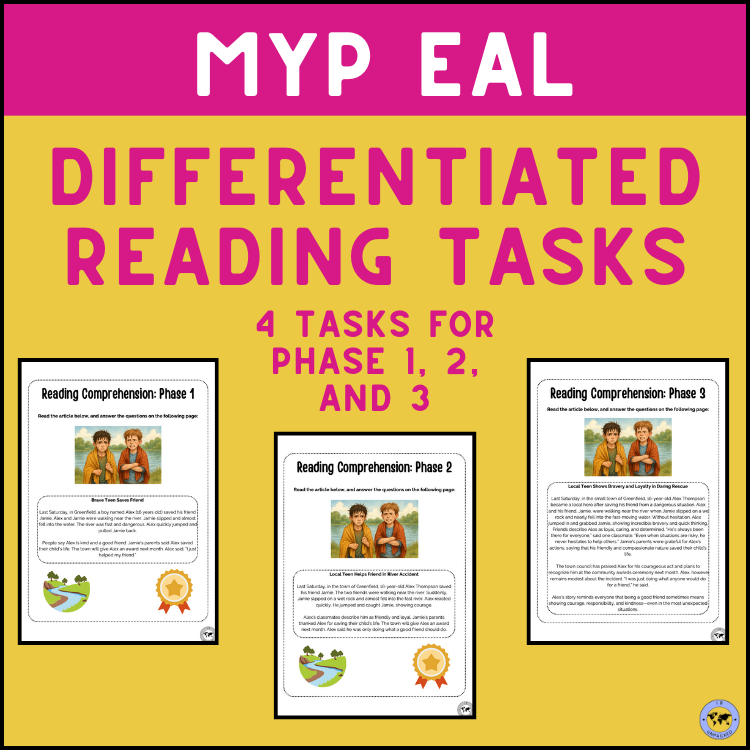Reading Between the Lines: Understanding Reading Comprehension in MYP Language Acquisition
If you’re new to the MYP, you’ve probably noticed that reading isn’t just about decoding text, but it’s about making meaning. In MYP Language Acquisition, Reading Comprehension is designed to mirror the way we actually encounter language in the real world, across screens, images, and words, so students learn to interpret text in all its modern, multimodal forms.
Let’s break down how reading is taught, assessed, and experienced in this dynamic framework.
1. How Reading is Taught
In the MYP, “reading” means more than just printed words on a page. Students engage with multimodal texts, which combine written language with visual, spatial, or even digital elements. Think websites, infographics, comics, blogs, or short stories with illustrations.
Teachers help students go beyond surface meaning. They learn to spot explicit information (facts, ideas, and details) and also to infer implicit meaning, which is the author’s tone, bias, or perspective. Students are encouraged to reflect, question, and connect what they read to their own experiences and cultural understanding.
This approach transforms reading from a passive skill into an active, analytical process.
2. How Reading is Assessed
Reading falls under Criterion B in the MYP assessment framework. Students are assessed on how well they can:
Identify explicit and implicit ideas and details
Recognize conventions of written text (like tone, style, and audience)
Analyse connections between the written text and accompanying images or layout
In practical terms, this might look like a comprehension task using a blog post, news article, or illustrated story. Students answer in the target language, showing they can interpret not just what’s written, but also how meaning is constructed through text type, layout, and visuals.
At higher phases, especially in MYP eAssessment, reading comprehension tasks often appear alongside listening, reflecting how these skills intertwine in real communication.
3. What Kind of Texts Are Used
The MYP strongly encourages authentic texts. This is the kind you’d actually encounter in the target language environment. That could include:
Short articles or blogs
Emails, ads, and social media posts
Literary excerpts or poems
Infographics, news clippings, or brochures
By using authentic materials, students see how language lives and breathes in everyday contexts. They learn to interpret both content and form, recognizing that a newspaper article, a tweet, and a fairytale each convey meaning differently.
4. Complexity and Progression Across Phases
Just like listening, reading complexity grows with each MYP phase:
Emergent (Phases 1–2): Simple texts with predictable structures, often supported by visuals and familiar topics.
Capable (Phases 3–4): Students begin to read longer, more varied texts: Articles, stories, and reports with some unfamiliar vocabulary.
Proficient (Phases 5–6): Texts become more sophisticated: Persuasive writing, opinion pieces, and culturally rich literature that invite analysis and evaluation.
As students advance, the focus shifts from “What does it say?” to “What does it mean?” and “Why is it written this way?”
5. Reading and Culture
One of the most rewarding parts of teaching reading in the MYP is exploring how language reflects culture. Students encounter idioms, humour, and values unique to the target language community. Teachers are encouraged to discuss cultural references and perspectives embedded in the text, which helps students build both linguistic and intercultural competence.
By reading widely and reflectively, students begin to see language as a mirror of culture, not just a set of words.
Final Thoughts
Reading in the MYP is about curiosity, and about helping students see text as a puzzle worth solving. When we teach them to read critically, we’re giving them tools to navigate meaning in a world overflowing with words and images.
As MYP teachers, our challenge (and joy!) is to curate texts that inspire, question, and connect. So bring in those blogs, poems, or memes, or anything that sparks engagement. Because in the MYP, reading is more than comprehension; its connection, culture, and creativity rolled into one.
